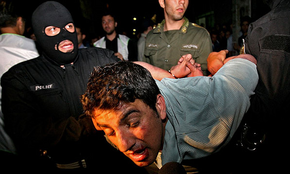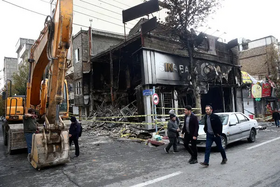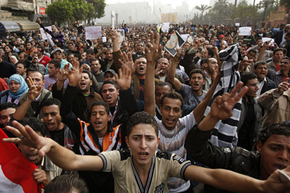User:Tranvea/Sandbox2: Difference between revisions
No edit summary |
|||
| Line 151: | Line 151: | ||
=== Federal elections === | === Federal elections === | ||
== 2007-2011 Chanwan Conflict == | |||
{{Infobox military conflict | |||
| conflict = 2007-2011 Chanwan Conflict | |||
| width = | |||
| partof = [[Chanwan conflicts]] | |||
| image = | |||
| image_size = | |||
| alt = | |||
| caption = | |||
| date = 14 April 2007 - 20 February 2011 | |||
| place = [[Zorasan]] | |||
| coordinates = <!--Use the {{coord}} template --> | |||
| map_type = | |||
| map_relief = | |||
| map_size = | |||
| map_marksize = | |||
| map_caption = | |||
| map_label = | |||
| territory = | |||
| result = Zorasani government victory | |||
| status = | |||
| combatants_header = | |||
| combatant1 = {{Flagicon|Zorasan}} [[Zorasan|Zorasani government]] | |||
* {{flagicon_image|ZIRAemblem.png}} [[Zorasani Irfanic Revolutionary Army|Zorasani armed forces]] | |||
* {{flagicon_image|Azab shoulder patch and emblem.png}} [[Wolves (organisation)|Wolves]] | |||
* [[Law enforcement in Zorasan|National Police Force]] | |||
| combatant2 = Chanwan Democratic Front<br>[[Chanwan People's Liberation Front|CPLF]]<br>[[Chanwan Resistance in Zorasan|CRIZ]] | |||
| commander1 = {{Flagicon|Zorasan}} [[Hamid Alizadeh]]<br>{{Flagicon|Zorasan}} [[Ali Reza Aref]]<br>{{Flagicon|Zorasan}} [[Alireza Fadavi]]<br>{{Flagicon|Zorasan}} [[Sadavir Hatami]] | |||
| commander2 = | |||
| commander3 = | |||
| units1 = | |||
| units2 = | |||
| units3 = | |||
| strength1 = [[Zorasani Irfanic Revolutionary Army|Zorasani armed forces]]: 186,988 (at height)<br>[[Wolves (organisation)|Wolves]]: ~30,000<br>[[Law enforcement in Zorasan|National Police Force]]: 111,483 (at height) | |||
| strength2 = CDF: ~32,000<br>CPLF: ~5,000-9,0000<br>CRIZ: ~3,500 | |||
| casualties1 = 5,347 soldiers, 283 police officers and 887 wolves killed, 95 captured | |||
| casualties2 = 18,494-20,777 killed and 11,608 captured | |||
| casualties3 = 34,257-56,884 civilians killed<br>10,683 missing or disappeared<br>586,500-900,000 displaced | |||
| notes = | |||
| campaignbox = | |||
}} | |||
Revision as of 19:53, 23 June 2020
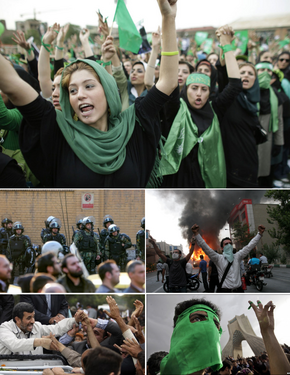 From the top clockwise: Women protesters in Faidah March 2005; Komiteh members in Borazjan; Komiteh member protesting near Inqelabe Tower in Zahedan; Hamid Alizadeh with supporters following his coalition's landslide victory in the July elections; Police standing by during protests in Qufeira. | |
| Date | 16 February 2005 – 19 July 2008 |
|---|---|
| Location | |
| Also known as | Revolutionary Rejuvenation Mission |
| Cause |
|
| Participants | |
| Outcome |
|
| Deaths | Uncertain; estimates range between 3,500-10,000 |
| Missing | Uncertain; estimates range between 3,530-15,500 |
The Hurricane (Pasdani: طوفان; Turfan; Badawiyan: زَوْبَعة; Zawbaʻa) is the name given to the period of political, social, cultural and ideological upheaval in Zorasan that occurred between 2005 and 2008, that marked the demise of the Saffron Era and the restoration of the hardline Sattarist civic-military regime.
Initially beginning as grass-roots political movement aimed at rooting out “ideological rejectionists”, Sattarist aligned student groups attacked and humiliated teachers and academics accused of “revolutionary treason.” The students’ actions quickly spread out into wider society, with attacks on employers, civil rights activists, reformist politicians, before escalating into score settling and chaotic denunciations.
The chaos would subside by late 2006 with the Zorasani government assuming direct control over the various movements, this coincided with the restoration of Revolutionary Tribunals and purges of non-conformist civil servants, politicians and civil society groups. The chaos and purges provided the cover for the creation of the 2008 Constitution, which entrenched the empowered armed forces as the ultimate political authority in the country and the restored domination of ideological Sattarism.
Attacks on non-Irfanic minorities skyrocketed during the 2005-08 period, alongside government restrictions on the civil liberties of especially the Chanwan minority. The banning of numerous Chanwan political groups, societies and the use of the Chanwan language in public sparked civil unrest, and ultimately 2007-2011 Chanwan Conflict, which would leave an estimated 12,000 people dead.
During the Hurricane, Zorasani media was shut down by the central government and virtually all social media sites were blocked. As a result, it is not known how many people were killed or disappeared during the period, however, some estimates put the number of killed at 3,500 to as high as 10,000. The number of documented people missing from the Hurricane years is only 100, independent analysis places the number between 3,530-15,500. The period stands as one of the most “significant political events of the early 21st century” and is widely recognised as “confirmation of Sattarism’s resilience and power in the modern age.”
Background
The origins of the Hurricane are still hotly debated to this day, with debates as to whether it was in fact a spontaneous grass roots act, or it was orchestrated by the Zorasani military. Several factors and preceding events are accepted as pivotal in producing the febrile atmosphere in Zorasan and the socio-political tensions that gave way to the mass violence.
Saffron Era
Beginning in 1990, with the election of XX and XX as State President and First Minister respectively, and the the People’s Democratic Coalition, the Saffron Era refers to a period of heightened democratic political activity and the liberalisation of both Zorasani politics and the economy. The period also saw the diminishing of military and clerical influence and power in the Zorasani state.
Economic reforms that either privatised or restructured state-owned enterprises and the opening of the country to more expansive foreign investment led to a prolonged economic boom that dramatically improved living standards and incomes. Political reforms pushed back the authoritarianism of the preceding years following the establishment of the UZIR in 1980, including the introduction of universal rights for Zorasan’s ethnosectarian minorities.
The election of XX and XX and the National Reform Front in 2000 however, marked the steady decline of the Saffron Era, owing to fierce and growing opposition from the military and clerical establishment toward planned reforms. The XX-XX administration’s laws rolling back the presence of Irfanic law and rumoured plans to secularise the Zorasani state in the early 2000s provoked bitter political battles and a resurgence of support for Sattarism among the traditionally conservative Zorasani populace. Poorly managed economic reforms aimed at reducing popular reliance on oil-funded subsidies and deep austerity crippled Zorasani economic growth and unleashed mass youth unemployment. The turn from booming economy to chronic stagnation was worsened by the onset of the 2005 Global Recession, which threw Zorasan into freefall by 2003. The military-clerical response to the recession proved convenient in their shared desire to restore their influence and power lost during the 1990s.
The hardline Sattarist political blocs, led by the True Way and aided by the military waged an effective media and propaganda campaign, placing the blame of Zorasan’s economic woes solely upon the liberal NRF government. This and the mass resentment toward the government resulted in the NRF’s collapse at the 2005 General Election, and the True Way coalition’s overwhelming landslide. Hardliner ideologues, Hassan Roshani and XX became State President and First Minister respectively and vowed to undo the “NRF’s annihilation of Zorasan.”
Recession and class conflict
Zorasan had been suffering economic stagnation, mass youth unemployment and declining exports since 2003, two years before the global economic crashed in 2005. The intervening years saw living standards in Zorasan fall for the first time since the UZIR’s founding in 1980. Youth unemployment nationally had reached 32% by the time of the 2005 recession, while adult unemployment had risen to 9% in wake of privatisations of unprofitable, but large SOEs. These hits struck the urban and rural working class the hardest.
The liberal government’s claims that its austerity measures and privatisation program was necessary to modernise and improve competitiveness failed to breakthrough. The seemingly unsympathetic behaviour of senior government officials only deepened popular anger toward the central government. Between 2002 and 2003, the government abolished over six separate subsidies funded by oil revenues that provided significant support for the unemployed and young workers. The abolition of the Youth Training Grant, a monthly payment to young men and women in vocational training sparked mass protests in mid-2003, which were seized upon by Sattarists as proof that the government had abandoned the founding tenets of the UZIR. The structural reforms to the Zorasani economic system were considered by some Euclean economists to be based upon shock therapy, with swathes of the nominally statist system being liberalised to private investment and purchase. The reforms were widely criticised as several major SOEs privatised had recorded sizeable profit margins in the preceding years, but had extensive ties to Zorasani military enterprises. The privatisation of the Ajad Coal and Mineral Corporation saw over 25,000 lay-offs. The ACMC was partially owned by the Great Soldier Foundation, the Zorasani military's principal holding company. Cases such as ACMC led many to see the Dalam-Kahala government's economic policy as a political agenda aimed at further undermining the military, at the expense of low-wage earning Zorasanis. The reforms proved successful in removing government obligations to supporting decaying or uncompetative SOEs but the shockwaves to the domestic supply chain had knock-on effects on the wider Zorasani manufacturing sector, which resulted in reduced exports. Reforms to Zorasani Union General Petroleum (Zorugen) were more disruptive than beneficial, with poorly executed changes to payroll, lower-management and failed streamlining of production undermining daily oil production. The events at Zorugen during 2003 caused limited instability in the global energy price but antagonised the House of Irfanic Workers, the country's largest trade union at the time and the principal union for oil workers.
Despite the chronic effects on the poor lower-classes, the reforms did succeed in improving systemic competitiveness and hastened the rate of diversification away from petrochemicals – a policy in place since 1980. The austerity and privatisation of inefficient SOEs resulted in a significant influx of revenues for the government, which were in turn directed into smaller and more professional sectors of the economy. The reforms enriched the urban and educated middle classes, who saw their incomes increase by almost 10% annually between 2000 and 2005. The refusal to direct the sums of money into the social safety net and the exuberant wage growth for the middle classes only deepened resentment among the urban and rural poor.
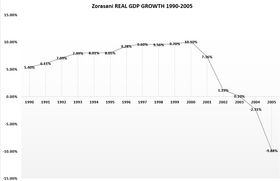
In the years leading up to the 2005 crash, the enriched middle class became ostentatious in their newfound wealth. As leading commentator of the time, Masoud Farad wrote, “even as the nation fell into an economic malaise, the middle classes flashed their wealth around the cities, new cars, new fashions, new jewellery, all was paraded in front of the miserable, destitute urban poor.”
By late 2004, the resent evolved into outright class conflict. Throughout December, high fashion stores, car showrooms and high-end restaurants were vandalised by groups of unemployed males in Zahedan, Borazjan, Faidah and Qufeira. The Irfanic Clerical establishment condemned the extravagant lifestyles of the middle class as “un-Irfanic and in gross violation of the Acts of Intercession.” The Sattarist right and the military also condemned the middle class for abandoning “national solidarity” and for “embracing Euclean materialistic greed.”
During the pre-2005 period, the Chanwan minority of southern Pardaran also began to see their social status and incomes increase. Many Chanwans at the time, constituted significant portions of the construction and services industry. The liberal government’s modernisation program saw major infrastructure projects being built across the country, where Chanwan workers were chosen for their penchant for longer hours and overtime. The growth of high-end establishments requiring staff saw Chanwans take up the well-paying positions. The combined profitable work in construction and services brewed further resentment among the Pardarian and Badawiyan working class, who saw Chanwan prosperity as an insult.
The onset of the 2005 global recession saw Zorasan’s already stagnant economy collapse into freefall. Youth unemployment exploded to 59% within a matter of months and the dramatic fall in energy prices decimated the government’s oil revenue stream. The loss of oil revenues was exacerbated by the fall in exports, which further denied access to capital. The ensuing recession deal heavy blows to the urban middle class, yet the working class suffered worse, with further cuts to Zorasan’s notably limited welfare system.
Political and ideological
The Saffron Era while noted for its liberalism, democratic reform and pro-market economic changes, it was a period of extreme partisanship and vicious political rivalry. The success of the liberal-reformist bloc in sweeping to power in 1990 and its subsequent success in reform gave way to ever increasing resistance from the military and clerical establishments, who not only opposed many of the reforms on political grounds, but also in their wish to preserve their influence and power.

The XX-XX administration scored numerous victories against the military and clerics, pushing them out completely from the national legislature in 1993. In 1994 the government succeeded in placing civilians in charge of the defence budget and regained control over the Union Ministry of State Intelligence and Security (MSIS). The rollback of censorship during the same year resulted in the marginalisation of the military in Zorasan’s media sector. The military’s failure to secure any officers being elected to the Superior Assembly in the 1995 election proved disastrous for its plans to halt the XX-XX administration. By the 2000 election, the military’s influence over Zorasani politics was at its weakest since 1980. This was proven by the Central Command Council’s denouncement of the new government as “inherently naive” had little to no impact on its standing in parliament.
The election of the Ekrem Dalam-Izzat al-Din Kahala administration and the National Reform Front however would prove to be a major turnaround for the Clerical-Military establishment. The 2000 election also saw a slight resurgence in the Sattarist faction, led by the True Way. The style of government by Dalam and Kahala antagonised many traditional conservative Zorasanis, who in turn became more supportive of the hardliners. In 2001, Hamid Alizadeh became the de-facto leader of True Way and was a highly adept political operator.
Aiding True Way and Roshani was the entire weight of the Ruhaniyyat (Clerical stratum), who saw the progressivism of the Dalam-Kahala government, as forbidden under Irfanic religious law. In the preceding years, the government came under sustained criticism and attack by Irfanic clerics both in the media and within religious establishments. Whether this sustained criticism was ordered by Supreme Custodian Ayatollah Ali Hassan Roshani is not known, though it was noted during the 2000-2005 period, the numerous publications released by the seminaries in Namrin and Ardakan with the Supreme Custodians permission were disparaging of the government.
Between 2002 and 2003, the government announced plans to loosen Irfanic religious law in Zorasan, including the possible abolition of the mandatory religious dress code, laws to permit special social zones for the sale and consumption of alcohol and the possible introduction of casinos to the new city of At-Turbah to promote tourism. These proposals sparked a nationwide backlash and is widely seen as turning the entire clerical establishment against the Dalam-Kahala government and liberal reformism. Leading cleric Ayatollah Adavazdar Emami Kushani wrote in 2003, “we find ourselves governed by the vain and egotistical. Condemned to suffer the inequities of their godlessness and dare I say, Kafir ways.” Emami-Kushani’s denouncement of the XX-XX government as “kafir” was controversial and sparked backlash from government supporters, while equally mobilising the religious opposition.
The influence the Ruhaniyyat’s position had on the working class student movement is debated still today, though commentators agree that the weekly denunciations during Friday Prayers for almost five years most certainly had a role to play in the break out of violence in 2005.
Timeline
2005
Zahedan University of Social Sciences
The Hurricane began with spontaneous student protests at the Zahedan University of Social Sciences on 16 February 2005, in response to a collaborative essay produced by economic and political science academics, claiming Zorasani unification had been ineffective in “creating a dynamic and beneficial economic system.”
The essay was first picked up by the national press who condemned it for its short-sightedness and tone-deafness on February 11. True Way Leader, Hamid Alizadeh described it as a “slap in the face for millions of Zorasanis struggling as these academics lavish themselves in luxuries.” This was followed by Ayatollah Adavazdar Emami-Kushani calling it a “hatchet job by the ignorant. These academics and their kafir leaders unleashed this economic depression us because they abandoned the ideals of the Arduous Revolution.”
The public denunciations provoked at least 80 students entering the main auditorium, dragging the authors before the assembled crowd, hurling insults and humiliating them. The students then occupied the hall, demanding the university administration denounce the essay and sack the authors. The scenes were broadcasted through social media sites, while the national press soon arrived to cover the protest. By the end of the day, the number of protesting students had grown to over 500 in the auditorium. The broadcasting of events unleashed similar actions in universities across Zorasan. The students at ZUSS would hold the auditorium for three days before being evicted by police.
February-March
On 17 February, 100 students stormed the class of Economist Farouk Sabahi at the Irfanic University of Faidah, claiming he was spreading “foreign lies” to his students. Sabahi, like the authors of the essay at the ZUSS, was dragged to the main auditorium, where he was insulted, slapped and humiliated. When some of his students attempted to intervene, they were attacked with six students hospitalised from being struck with batons.
Sabahi was held and forced to admit that he had “spread lies and poison” about Sattarism and was an agent for the “collapse of the Union.” His forced confession was broadcasted onto social media and replayed hourly by the national press. State TV, which was stacked with pro-Sattarist elements condemned the economist and took his confession at face value.
The attacks on academics escalated within days, with 36 universities reporting incidents. The Metropolitan University of Borazjan saw 600 students ransack the political science department on February 19, while students at the Davood Shirazi University in Soltanabad saw its library emptied of foreign produced books and the publications burnt in the campus park.
On February 20, the head of the history department at the Imam Reza University in Zahedan was shot by a student as he debated with protesting students. He was later confirmed dead at hospital. Student action spread to a further 29 universities, where the first signs of an organised movement appeared. The next day, First Minister Al-Din Kahala requested an emergency meeting of the Central Command Council to discuss the situation. His calls for federal responses were blocked by the armed forces who claimed it was for the Union Republics to deal with. Efforts by the Dalam-Kahala government to secure a federal response would be blocked repeatedly until the general election.
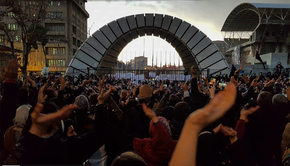
The students occupying their auditoriums by the start of March, began proclaiming themselves members of “People’s Revolutionary Committees” (Komitehāye Enqelābe-e Tūde'hā) and were dedicated to the “restoration of Sattarist virtues to the Union.” Efforts by the Federal government to see the KETs removed from universities failed as UR-level police forces either stood by or in some cases aided the students in apprehending academics. March saw continued increases in the number of protesting students, nearly all exclusively drawn from the urban and rural working classes. As their numbers grew, the KETs began to make grander demands, including the resignation of the Dalam-Kahala government and immediate elections.
On March 13, over 35,000 unemployed workers in Zahedan marched in protest against the government and its economic policies. The route took them from Enqelabe Square to the ZUSS, where they joined with the students.
On March 14, the government announced plans to bail out over 200 privately owned companies, confirmed to be tied to middle class businesspeople. The news was immediately followed by reports that several large SOEs employing over 100,000 people in total were to go into liquidation. Pro-Sattarist news outlets swiftly condemned it as the actions of a corruption government aiding its narrow minority base at the expense of the downtrodden. The consequences were immediately revealed, with hundreds of thousands of jobless taking to the streets across Zorasan.
On March 16, the number of protesters joining the Komitehs grew exponentially. Efforts by the Dalam-Kahala government to deploy federal resources to combat the Komitehs was stonewalled by the Central Command Council. This led to the government establishing direct lines of communications to pro-government states, who began to deploy state police against the protesters to some degree of success.
The government aligned governors of Ajad, Irvadistan and Ninevah ordered the closure of their Union Republic’s universities on March 17. This was met by Komitehs in Irvadistan ransacking the administrative offices of the Qufeira University of Engineering, copying the addresses of academics teaching at the institution. Throughout the night of March 17, six academics were dragged from their homes back to the university to be forced into confessing the spread of lies and propaganda. Two other academics were attacked and seriously injured in their homes, while a third, Hussein al-Tabani went missing. Al-Tabani’s body was discovered a week later in the outskirts of the city.
On March 20, State President Ekrem Dalam took to national television to urge for calm. However, his speech backfired with his accusation that “nefarious reactionary elements were manipulating life’s unfortunate losers.” His statement was taken as an insult to the estimated 57 million unemployed and enflamed tensions among the socio-economic classes.
The speech was followed by mass protests that rapidly escalated in riots in Irvadistan and Ninevah, while the mass marches in Khazestan, Riyadha and Pardaran were mostly peaceful owing to the near absent police presence. The riots in Irvadistan and Ninevah descended into unrestrained vandalism and violence, with newspaper offices, the regional branches of pro-reform coalitions, the homes of academics and the homes of noted international-focused businesspeople being sacked or burnt. Random people, felt to be unconditional in their support for Sattarist ideals and the Union were attacked and brought before ad-hoc “People’s Tribunals” established inside Mazars, Social Clubs and public squares, where they were humiliated or beaten. In isolated cases in rural Irvadistan and Ninevah, those suspected of being disloyal to the Union were disappeared by the Komitehs. Throughout the night of March 20, riot police in Ninevah and Irvadistan battled with the Komitehs and other protesters, succeeding in defending key individuals. The same night, First Minister Kahala also achieved some limited success in securing direct meetings with the senior figures on the Central Command Council, side-lining State President Dalam. According to government insiders following the Hurricane, Dalam’s speech all but guaranteed his marginalisation from decision making as First Minister Al-Din Kahala sought to confront the crisis head-on, suspecting that the Armed Forces had whipped up the initial protests at ZUSS. The events of March 20 left 21 people dead and over 2,000 injured, while a further 89 people were reported missing.
The next day saw repeated mass protests across the country, while the country’s largest trade union, House of the Irfanic Worker announced plans to hold a vote on its industrial workers going on strike in solidarity with the Komitehs. An emergency session of the Popular Assembly was held, where First Minister Kahala promised to address the concerns of the Komitehs while also expressing dismay at the violence and destruction. His address was marred by continuous heckling by Sattarist factions, who called for his resignation. Protests during the night of March 21 went on more peacefully, with the Komitehs leading marches. No reported “tribunals” where held anywhere in the country.
On March 22, First Minister Kahala held talks with General Sadavir Hatami the designated representative of the CCC. The two agreed that the violent attacks against academics had to stop, otherwise the threat to Zorasani academia and intellectual productivity would collapse. Gen. Hatami reportedly told Kahala that the military shared concerns for a brain drain. While the two could not overcome the fundamental divisions between the reformist government and the Sattarist dominated military, the two agreed to permit the deployment of soldiers to universities to clear out the Komitehs peacefully, while the army would also provide personal security for academics involved in social sciences.
It is widely accepted that throughout March, the Sattarist faction of Zorasani politics, spearheaded by the Ruhaniyyat and the security forces, had established strong ties with the Komitehs. This was achieved to such a degree of success, that attacks on the homes of academics all but stopped by the start of June. However, the attacks would resume in highly targeted manners following the general election in July.
June-July
Federal elections
2007-2011 Chanwan Conflict
| 2007-2011 Chanwan Conflict | |||||||
|---|---|---|---|---|---|---|---|
| Part of Chanwan conflicts | |||||||
| |||||||
| Belligerents | |||||||
|
Chanwan Democratic Front CPLF CRIZ | |||||||
| Commanders and leaders | |||||||
|
| |||||||
| Strength | |||||||
|
Zorasani armed forces: 186,988 (at height) Wolves: ~30,000 National Police Force: 111,483 (at height) |
CDF: ~32,000 CPLF: ~5,000-9,0000 CRIZ: ~3,500 | ||||||
| Casualties and losses | |||||||
| 5,347 soldiers, 283 police officers and 887 wolves killed, 95 captured | 18,494-20,777 killed and 11,608 captured | ||||||
|
34,257-56,884 civilians killed 10,683 missing or disappeared 586,500-900,000 displaced | |||||||

